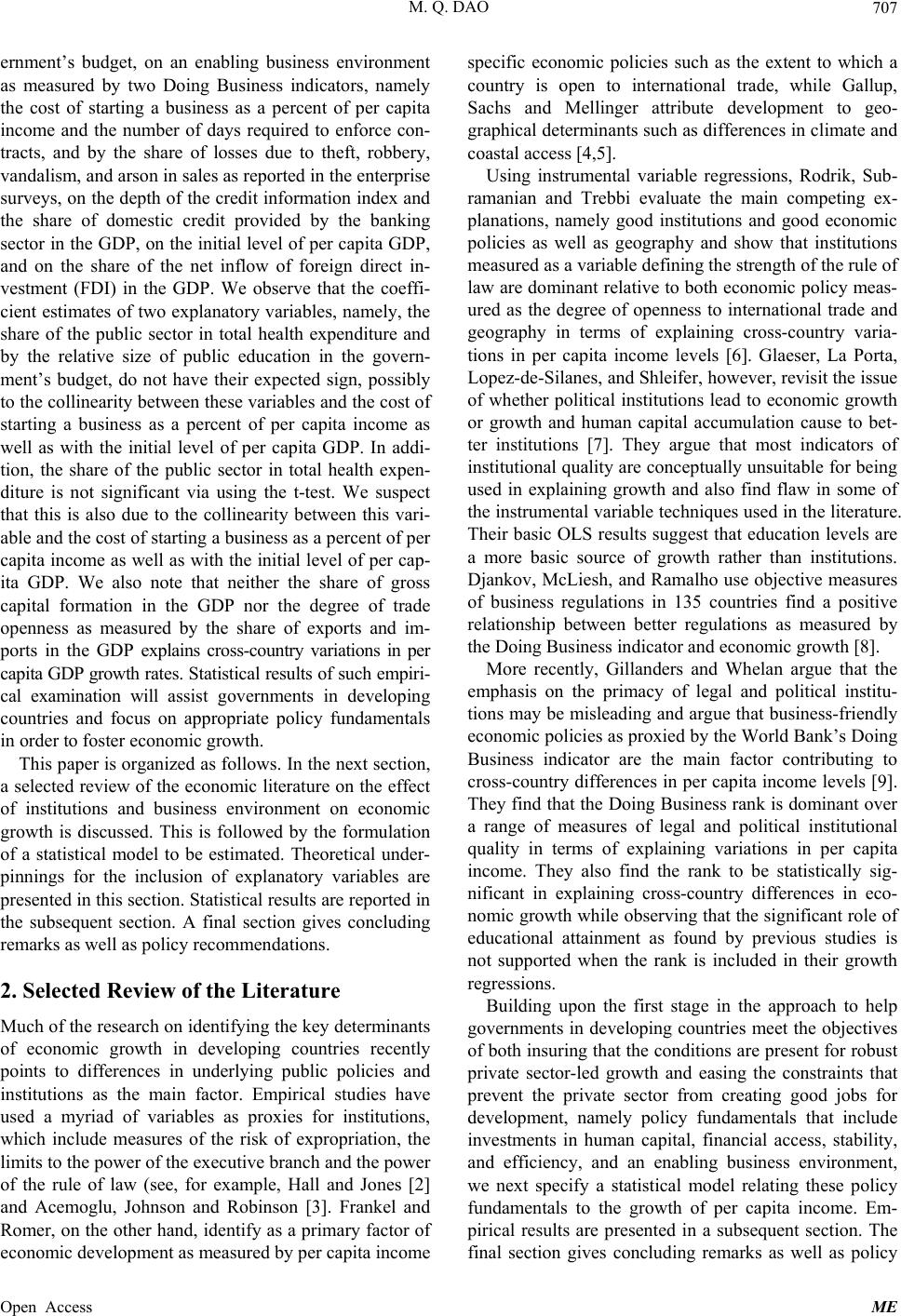
M. Q. DAO 707
ernment’s budget, on an enabling business environment
as measured by two Doing Business indicators, namely
the cost of starting a business as a percent of per capita
income and the number of days required to enforce con-
tracts, and by the share of losses due to theft, robbery,
vandalism, and arson in sales as reported in the enterprise
surveys, on the depth of the credit information index and
the share of domestic credit provided by the banking
sector in the GDP, on the initial level of per capita GDP,
and on the share of the net inflow of foreign direct in-
vestment (FDI) in the GDP. We observe that the coeffi-
cient estimates of two explanatory variables, namely, the
share of the public sector in total health expenditure and
by the relative size of public education in the govern-
ment’s budget, do not have their expected sign, possibly
to the collinearity between these variables and the cost of
starting a business as a percent of per capita income as
well as with the initial level of per capita GDP. In addi-
tion, the share of the public sector in total health expen-
diture is not significant via using the t-test. We suspect
that this is also due to the collinearity between this vari-
able and the cost of starting a business as a percent of per
capita income as well as with the initial level of per cap-
ita GDP. We also note that neither the share of gross
capital formation in the GDP nor the degree of trade
openness as measured by the share of exports and im-
ports in the GDP explains cross-country variations in per
capita GDP growth rates. Statistical results of such empiri-
cal examination will assist governments in developing
countries and focus on appropriate policy fundamentals
in order to foster economic growth.
This paper is organized as follows. In the next section,
a selected review of the economic literature on the effect
of institutions and business environment on economic
growth is discussed. This is followed by the formulation
of a statistical model to be estimated. Theoretical under-
pinnings for the inclusion of explanatory variables are
presented in this section. Statistical results are reported in
the subsequent section. A final section gives concluding
remarks as well as policy recommendations.
2. Selected Review of the Literature
Much of the research on identifying the key determinants
of economic growth in developing countries recently
points to differences in underlying public policies and
institutions as the main factor. Empirical studies have
used a myriad of variables as proxies for institutions,
which include measures of the risk of expropriation, the
limits to the power of the executive branch and the power
of the rule of law (see, for example, Hall and Jones [2]
and Acemoglu, Johnson and Robinson [3]. Frankel and
Romer, on the other hand, identify as a primary factor of
economic development as measured by per capita income
specific economic policies such as the extent to which a
country is open to international trade, while Gallup,
Sachs and Mellinger attribute development to geo-
graphical determinants such as differences in climate and
coastal access [4,5].
Using instrumental variable regressions, Rodrik, Sub-
ramanian and Trebbi evaluate the main competing ex-
planations, namely good institutions and good economic
policies as well as geography and show that institutions
measured as a variable defining the strength of the rule of
law are dominant relative to both economic policy meas-
ured as the degree of openness to international trade and
geography in terms of explaining cross-country varia-
tions in per capita income levels [6]. Glaeser, La Porta,
Lopez-de-Silanes, and Shleifer, however, revisit the issue
of whether political institutions lead to economic growth
or growth and human capital accumulation cause to bet-
ter institutions [7]. They argue that most indicators of
institutional quality are conceptually unsuitable for being
used in explaining growth and also find flaw in some of
the instrumental variable techniques used in the literature.
Their basic OLS results suggest that education levels are
a more basic source of growth rather than institutions.
Djankov, McLiesh, and Ramalho use objective measures
of business regulations in 135 countries find a positive
relationship between better regulations as measured by
the Doing Business indicator and economic growth [8].
More recently, Gillanders and Whelan argue that the
emphasis on the primacy of legal and political institu-
tions may be misleading and argue that business-friendly
economic policies as proxied by the World Bank’s Doing
Business indicator are the main factor contributing to
cross-country differences in per capita income levels [9].
They find that the Doing Business rank is dominant over
a range of measures of legal and political institutional
quality in terms of explaining variations in per capita
income. They also find the rank to be statistically sig-
nificant in explaining cross-country differences in eco-
nomic growth while observing that the significant role of
educational attainment as found by previous studies is
not supported when the rank is included in their growth
regressions.
Building upon the first stage in the approach to help
governments in developing countries meet the objectives
of both insuring that the conditions are present for robust
private sector-led growth and easing the constraints that
prevent the private sector from creating good jobs for
development, namely policy fundamentals that include
investments in human capital, financial access, stability,
and efficiency, and an enabling business environment,
we next specify a statistical model relating these policy
fundamentals to the growth of per capita income. Em-
pirical results are presented in a subsequent section. The
final section gives concluding remarks as well as policy
Open Access ME